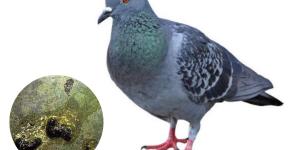Infectious Coryza in Chickens - Symptoms and Treatment



See files for Hens and roosters
Avian infectious coryza is an upper respiratory tract infection caused by Avibacterium paragallinarum. The disease affects only chickens, especially laying hens and occasionally broilers. Reports of quail and pheasants probably describe a similar disease caused by a different bacterium. At first glance it appears to be a simple cold, but the truth is that in the long run it can have very serious consequences.
The following AnimalWised article explains what infectious coryza in chickens is, its symptoms and how it is treated.
What is infectious coryza in chickens?
Infectious coryza, as mentioned above, is a respiratory disease caused by a bacterium called Avibacterium paragallinarum. Other names for this disease are cold, catarrh, infectious catarrh, roup, and hemophilus infection. The first symptoms appear about 2-3 days after infection. It is a highly contagious disease with sometimes significant mortality.
It is known that the bacterium can survive for days in low-oxygen environments, such as water or feces. The bacterium also survives in birds kept as carriers, which are usually asymptomatic, meaning they appear perfectly healthy to us. In reality, they are the main reservoir of the bacterium. Infection occurs through direct or indirect contact and via contaminated water and feed. In general, inadequate biosecurity practices and environmental factors contribute to the spread of the disease.
In low- and middle-income countries, the disease often occurs in very young chicks, less than 3 weeks old. In other countries like the United States, however, the disease occurs mainly in adult chickens. The reason for this is not yet known. This is because infectious coryza is not a zoonosis and therefore has no public health significance. Therefore, not enough studies have been done to really understand how and why the disease is transmitted.
Symptoms of infectious coryza in chickens
The clinical picture of infectious coryza lasts for two to three weeks, although it may extend depending on severity and the presence of other bacteria and viruses, such as mycoplasmosis. Symptoms that occur include the following:
- Runny nose
- Swelling of the face due to edema or fluid retention.
- Eyes may appear closed due to inflammation.
- Shaking and scratching of the head.
- Sneezing
- Coughing
- Difficulty breathing
- Anorexia
- Diarrhea
- Lethargy
- Change in color of the beards or chin (which take on a bluish hue and in roosters they become inflamed).
- Egg production may be delayed
Infectious coryza in chickens is more severe than a common cold in humans. Breeders and veterinarians describe it as a severe cold, but with more long-term and short-term effects. In uncomplicated cases, the IC course is about 7-11 days. If coexisting infections complicate the disease, the course may be a month or longer.

Treatment of infectious coryza in chickens
Since infectious coryza it is a bacterial disease, so it must be treated with antibiotics, which of course must always be prescribed by a veterinarian. Wrong antibiotics given to your poultry can not only be inefficient. It can also endanger your chickens in the long run and develop antibiotic resistance. Treatment consists of the use of antibiotics such as erythromycin, dihydrostreptomycin, streptomycin, sulfonamides, tylosin and fluoroquinolones.
Because early treatment is important, immediate administration of drugs through the drinking water is recommended. In the most severe cases, when chickens are neither eating nor drinking, antibiotics can also be administered by injection. However, medications cannot completely eliminate the disease because birds that recover may remain carriers and spread the disease to other birds.
Preventive administration of drugs can be combined with a vaccination program if pullets are to be raised or housed on infected farms. Commercial vaccines against infectious coryoza, usually based on killed H. paragallinarum, are available worldwide. Controlled exposure to live organisms has also been used to produce protective immunity in laying hens in endemic areas.

Prevention of infectious coryza in chickens
The most important prevention strategies are comprehensive management and sound biosecurity practices combined with appropriate vaccination. Good management, sanitation, and an all-in and all-out program are the best methods to prevent an outbreak of infectious coryza outbreak.
It is critical that they keep all their food and water containers clean, even if this is the least possible source of the bacteria. Transmission through contaminated food and water only occurs if a sick chicken secretes a secretion that enters the water or food supply. While this is unlikely, it can also result in other chickens becoming infected with the bacteria.
Also, you can kill the IC organisms by heating, drying and disinfecting. Therefore, proper sanitation practices are a must. This means you should clean coops at least twice a year or more. And if your chickens' coop is cold and damp, you may need to renovate it to keep your chickens warm and dry.
Avoid contact between susceptible and infected birds. If an outbreak occurs, separate affected birds and carriers from the rest of the flock. We can discuss with the veterinarian whether vaccination against distemper in birds is appropriate in our case.
The vaccine does not prevent the infection, but it minimizes the clinical picture and reduces the spread of the bacteria. If we want to increase the bird family, the new arrival must go through a quarantine period. This is because no matter how healthy the chicken looks, it can be a carrier.
If you want to know more about other common diseases in chickens, read our other articles on common chicken diseases.
This article is purely informative. AnimalWised does not have the authority to prescribe any veterinary treatment or create a diagnosis. We invite you to take your pet to the veterinarian if they are suffering from any condition or pain.
If you want to read similar articles to Infectious Coryza in Chickens - Symptoms and Treatment, we recommend you visit our Infectious diseases category.
Crank, Rhonda. (2019). 5 Common Chicken Diseases and Symptoms . Backyard Poultry.







